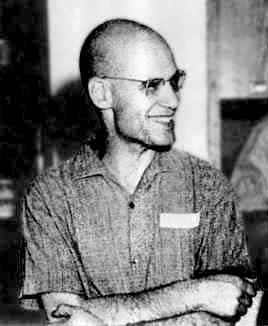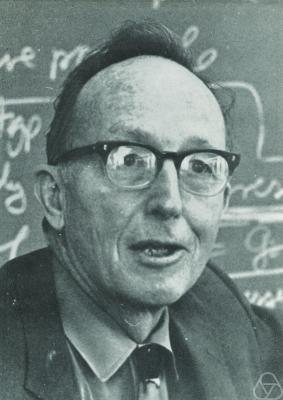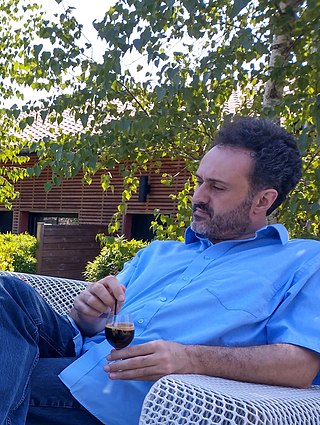
Alexander Grothendieck, later Alexandre Grothendieck in French, was a German-born French mathematician who became the leading figure in the creation of modern algebraic geometry. His research extended the scope of the field and added elements of commutative algebra, homological algebra, sheaf theory, and category theory to its foundations, while his so-called "relative" perspective led to revolutionary advances in many areas of pure mathematics. He is considered by many to be the greatest mathematician of the twentieth century.

Vladimir Alexandrovich Voevodsky was a Russian-American mathematician. His work in developing a homotopy theory for algebraic varieties and formulating motivic cohomology led to the award of a Fields Medal in 2002. He is also known for the proof of the Milnor conjecture and motivic Bloch–Kato conjectures and for the univalent foundations of mathematics and homotopy type theory.

Saunders Mac Lane, born Leslie Saunders MacLane, was an American mathematician who co-founded category theory with Samuel Eilenberg.
Daniel Gray Quillen was an American mathematician. He is known for being the "prime architect" of higher algebraic K-theory, for which he was awarded the Cole Prize in 1975 and the Fields Medal in 1978.
In mathematics, Brown's representability theorem in homotopy theory gives necessary and sufficient conditions for a contravariant functor F on the homotopy category Hotc of pointed connected CW complexes, to the category of sets Set, to be a representable functor.

John Frank Adams was a British mathematician, one of the major contributors to homotopy theory.

Michael Artin is an American mathematician and a professor emeritus in the Massachusetts Institute of Technology Mathematics Department, known for his contributions to algebraic geometry.

Alexander A. Beilinson is the David and Mary Winton Green University professor at the University of Chicago and works on mathematics. His research has spanned representation theory, algebraic geometry and mathematical physics. In 1999, Beilinson was awarded the Ostrowski Prize with Helmut Hofer. In 2017, he was elected to the National Academy of Sciences. In 2018, he received the Wolf Prize in Mathematics and in 2020 the Shaw Prize in Mathematics.
In mathematics, topological modular forms (tmf) is the name of a spectrum that describes a generalized cohomology theory. In concrete terms, for any integer n there is a topological space , and these spaces are equipped with certain maps between them, so that for any topological space X, one obtains an abelian group structure on the set of homotopy classes of continuous maps from X to . One feature that distinguishes tmf is the fact that its coefficient ring, (point), is almost the same as the graded ring of holomorphic modular forms with integral cusp expansions. Indeed, these two rings become isomorphic after inverting the primes 2 and 3, but this inversion erases a lot of torsion information in the coefficient ring.

Michael Jerome Hopkins is an American mathematician known for work in algebraic topology.
In mathematics, a highly structured ring spectrum or -ring is an object in homotopy theory encoding a refinement of a multiplicative structure on a cohomology theory. A commutative version of an -ring is called an -ring. While originally motivated by questions of geometric topology and bundle theory, they are today most often used in stable homotopy theory.

Richard Paul Winsley Thomas is a British mathematician working in several areas of geometry. He is a professor at Imperial College London. He studies moduli problems in algebraic geometry, and ‘mirror symmetry’—a phenomenon in pure mathematics predicted by string theory in theoretical physics.
Derived algebraic geometry is a branch of mathematics that generalizes algebraic geometry to a situation where commutative rings, which provide local charts, are replaced by either differential graded algebras, simplicial commutative rings or -ring spectra from algebraic topology, whose higher homotopy groups account for the non-discreteness of the structure sheaf. Grothendieck's scheme theory allows the structure sheaf to carry nilpotent elements. Derived algebraic geometry can be thought of as an extension of this idea, and provides natural settings for intersection theory of singular algebraic varieties and cotangent complexes in deformation theory, among the other applications.
Higher Topos Theory is a treatise on the theory of ∞-categories written by American mathematician Jacob Lurie. In addition to introducing Lurie's new theory of ∞-topoi, the book is widely considered foundational to higher category theory. Since 2018, Lurie has been transferring the contents of Higher Topos Theory to Kerodon, an "online resource for homotopy-coherent mathematics" inspired by the Stacks Project.
Michael "Mike" Shulman is an American associate professor of mathematics at the University of San Diego who works in category theory and higher category theory, homotopy theory, logic as applied to set theory, and computer science.

Bertrand Toën is a mathematician who works as a director of research at the Centre national de la recherche scientifique (CNRS) at the Paul Sabatier University, Toulouse, France. He received his PhD in 1999 from the Paul Sabatier University, where he was supervised by Carlos Simpson and Joseph Tapia.
Mikhail Kapranov, is a Russian mathematician, specializing in algebraic geometry, representation theory, mathematical physics, and category theory. He is currently a professor of the Kavli Institute for the Physics and Mathematics of the Universe at the University of Tokyo.
Charles Waldo Rezk is an American mathematician, specializing in algebraic topology and category theory.

Bhargav Bhatt is an Indian-American mathematician who is the Fernholz Joint Professor at the Institute for Advanced Study and Princeton University and works in arithmetic geometry and commutative algebra.
Dustin Clausen is an American-Canadian mathematician known for his contributions to algebraic K-theory and the development of condensed mathematics, in collaboration with Peter Scholze. His research interests include the intersections of number theory and homotopy theory.










